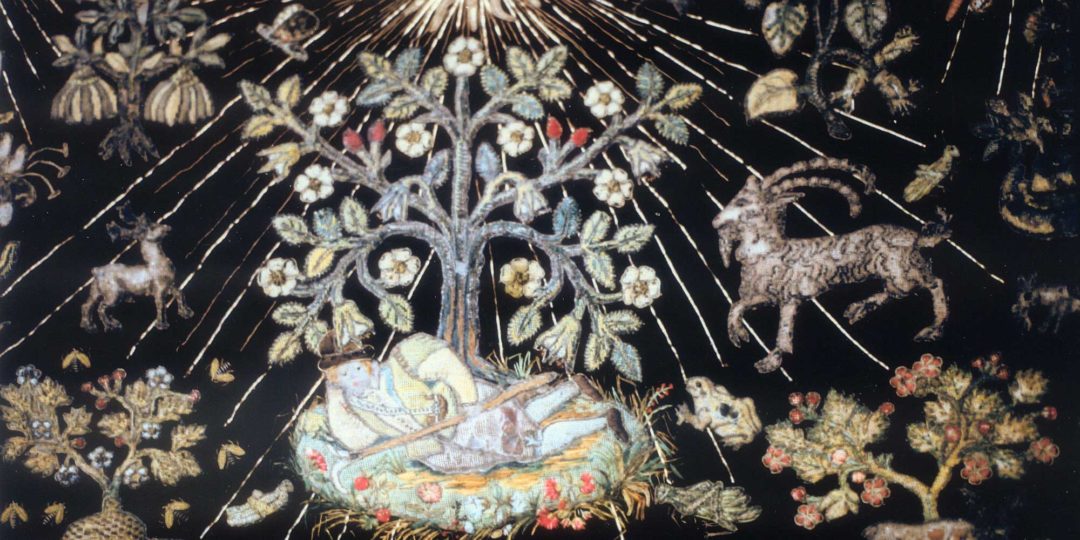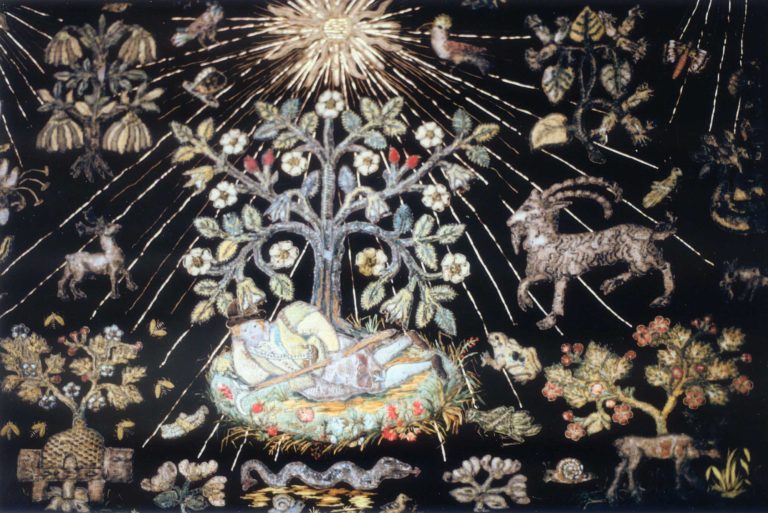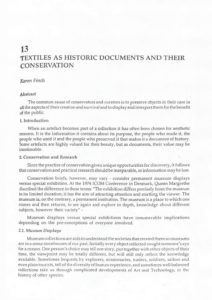Textiles as historic documents and their conservation
- Nov 16, 2018
- By Stephen Cole
- In Articles + Papers
First published 1996 in Recent Trends in Conservation of Art Heritage
The common cause of conservators and curators is to preserve objects in their care in all the aspects of their creation and survival and to display and interpret them for the benefit of the public.
When an artefact becomes part of a collection it has often been chosen for aesthetic reasons. It is the information it contains about its purpose, the people who made it, the people who used it and the people who preserved it that makes it a document of history. Some artefacts are highly valued for their beauty, but as documents, their value may be inestimable.
Since the practice of conservation gives unique opportunities for discovery, it follows that conservation and practical research should be inseparable, or information may be lost.
Conservation briefs, however, may vary – consider permanent museum displays versus special exhibition. At the 1974 ICOM Conference in Denmark, Queen Margrethe described the difference in these terms: “The exhibition differs precisely from the museum in its limited duration; it has the aim of attracting attention and startling the viewer. The museum is, on the contrary, a permanent institution. The museum is a place to which one comes and then returns, to see again and explore in depth, knowledge about different subjects, however their variety”.
Museum displays versus special exhibitions have innumerable implications depending on the pre-conceptions of everyone involved.
2.1. Museum Displays
Museum collections are aids to understand the societies that created them so museums are in a sense storehouses of our past. Initially every object collected caught someone’s eye for a reason. One person’s choice may tell one story, put together with other objects of their time, the viewpoint may be totally different, but will still only reflect the knowledge available. Sometimes bequests by explorers, missionaries, traders, soldiers, sailors and even plain tourists, tell of the diversity of human experience, and sometimes well balanced collections take us through complicated developments of Art and Technology, or the history of other species.
Displays may be biased according to the interests of everyone concerned and the way we unconsciously and automatically reflect the fashion of our day in any choice of display – nevertheless artefacts help to give us an understanding of the way we live and the influence of national and international relationships on the development of our surroundings.
Not all collections tell their story in a museum environment. The contents of a Historic House may show the organic growth of possessions that reflect the interest of successive generations of one family. This growth may generate related interests for as long as the house is privately owned. Public ownership usually means that displays are arrested to suit a particular fashion in the past of the house, often the time of its most illustrious occupier.
Displays of treasured heirlooms in a family setting, may not be as environmentally safe as those in public places, and conservators may sometimes have to devise individual measures for their safe-keeping, in close collaboration with their owners.
2.2. Special Exhibitions
Objects in special exhibitions may come from afar to be shown together – often, it is true, to attract attention and startle the viewers by enticing displays and new information, and a chance to marvel about the extent of collections normally hidden from public view. Special exhibitions may have to be set up against time with curators as well as conservators, regretting that objects should just pass through with no pause for academic study, documentation or scientific comparison with similar material and techniques, even though the objects on exhibition may never be brought together again.
Wasted opportunities to develop greater understanding are always to be regretted, perhaps even more so when objects are no longer in the care of curators with responsibility for their study and interpretation, but are considered parts of service collections to be used like theatrical props.
Conservators are trained to work on the basis of a practical and scientific investigation into fibres, dyestuffs, finishes, techniques, stains, wearmarks and creases and to conclude with a full report on each commission or project. In the transition period following museum re-organisation, they may find the briefs given them by service collection managers and exhibition designers inappropriate to the objects as historic documents.
Conflicts will be inevitable unless all of the professionals involved have received complementary training and agree that the integrity of the objects must be respected in all the circumstances of their keeping.
Perhaps now is the time to draw attention to the fact that textile conservation as a concept allied to research is nearing its first centenary. It started in Sweden with the creation of Pietas in 1908, for the purpose of conserving historic textiles under antiquarian control.
In the festschrift in honour of Agnes Geijer, Opera Textilia (Stockholm, 1988), Inger Estham states “right from the beginning every single object conserved was documented by means of photography, a descriptive text and exact particulars concerning its condition and the measures taken.”
These records have continued to assist with further research in the light of new discoveries and scientific progress. Conservation can never be an end in itself, because the aids to understanding as well as the people who do the research are constantly developing. The Swedish lead has influenced the work of museums throughout the world, establishing a growing perception of the creative relationship between mind and matter.
Comprehension and interpretation depend on the knowledge possessed by the researcher, and knowledge grows in step with developments in many fields. Today, we are able to interpret stains and creases in textiles, and dress made from textiles, as well as to identify fibres, dyestuffs and techniques of making. We can learn to take advantage of all modern facilities for physical and academic research, but no one can master all disciplines. Teamwork is essential, if we are to conserve, understand and interpret any document of history in all its cultural and scientific contexts.
For many reasons, the most fruitful time to investigate and note the physical aspects of an object is during conservation, when it may be seen and examined inside and out, and when every expertise is readily to hand. Scientists and conservators need to identify the materials, techniques and damage of the objects they conserve. They can be more certain of the success of their interventions when they can put their physical knowledge in relation to the known age of the object, and the use made of it since it was created. They need to know too the conditions under which it was kept or displayed, because of the changes these may have caused which might otherwise be inexplicable.
Curators may have the answer to most of the questions raised, and should ensure that their information follows the object, and that conservators have access to both the records of its past, and the plans for its future likewise, the conservator must ensure that the curator is apprised of all observations. Together conservators and curators may benefit from the need for conservators to establish their own physical knowledge of the object through their own observations, measurements and analysis, because new methods and new equipment may tell a different story to past records. Sometimes aspects are confirmed, and sometimes revision and consequent shared research has led to exciting discoveries through team members relating their findings to previous work, or studies in libraries, or other museums or laboratories. Together we achieve more than singly, because team work gives access to many more resources.
From all points of view, it is desirable, that the treatment of all objects should follow similar procedures – with any deviation being discussed by all members of the team, including the owner, curator or historian, collection manager, conservator and conservation scientist. Together the team should outline the procedure for each object, according to what is already known about it, including its provenance, and how and why it was created.
The conservator and the scientist will need to know the physical history of the object, including as stated before, the conditions of its keeping on display and in storage, together with the reports on any previous conservation for the purpose of evaluating their combined effects on the object and its individual components.
The curator/historian may have a series of questions related to this evaluation concerning wearmarks, creases, alterations, patches and darns, fading, dirt and stains, to either prove or disprove theories concerning the place in history of the object and its original owners and creators. They may need to put the answers in context with archival and field studies and new knowledge gained on similar objects in other museums or collections which might involve every aspect of their existence from the techniques by which they were made, to re-modelling for a different purpose in the course of time and new demands.
The collection manager will need to know how the effect of any treatment will affect the storage required, or the eventual display of the object or any travel arrangements that may have to be made.
The strength of the team stems from the specific interests of each team member, which guarantees the best possible consideration of each object in their care. Close collaboration will always get the most stimulating results – and the safest for the object. This becomes especially apparent when historical research dictates radical intervention that may be contrary to conservation needs, but which is essential for the purpose of establishing historical identification.
It is important that all agree on the methods of research and documentation and on how responsible conservation can be made compatible with attractive presentation, but it is equally important to extract all the information attainable by present day investigative methods, and to make records that will be easily available to future researchers, who may be intent on research into areas only tangentially related.
Understanding may not be instantaneous, research into the past rarely goes in a straight line. New investigative techniques may suddenly illuminate areas that were feared lost in time, because thought processes go on simultaneously underneath as well as on the surface making connections and overturning barriers to comprehension, and new discoveries may lead from an understanding in spirit to a basis of facts.






You are not currently logged in. Please log in or register for an account or leave a comment as a guest below.